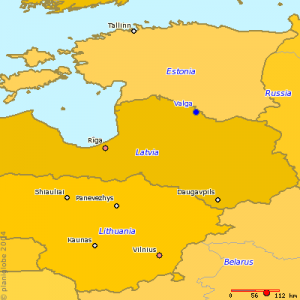Difference between revisions of "Baltic Soviet Socialist Republics"
| [checked revision] | [checked revision] |
GameoAdmin (talk | contribs) (CSV import - 20130820) |
m (Text replace - "emigrated to" to "immigrated to") |
||
| Line 5: | Line 5: | ||
The first families to come were often scattered, and there were too few in any particular locality to form their own congregations. Some families, for example, moved to Kokhta Jarve in Latvia, and joined a registered Baptist congregation. For a while they were able to hold their own German services, but state influence caused the local [[Baptists |Baptists]] to restrict their activities, so all the Germans and a number of Russians moved away. | The first families to come were often scattered, and there were too few in any particular locality to form their own congregations. Some families, for example, moved to Kokhta Jarve in Latvia, and joined a registered Baptist congregation. For a while they were able to hold their own German services, but state influence caused the local [[Baptists |Baptists]] to restrict their activities, so all the Germans and a number of Russians moved away. | ||
| − | In 1972, this group was able to secure its own church building, and register as a Methodist affiliate. This mixed Mennonite group became a Methodist congregation this way. Eventually, however, all the Germans in this group | + | In 1972, this group was able to secure its own church building, and register as a Methodist affiliate. This mixed Mennonite group became a Methodist congregation this way. Eventually, however, all the Germans in this group immigrated to West Germany. |
In Valga, too, the congregation met in a Latvian Baptist church building, holding separate German services on Sundays, and Bible study meetings during the week. A group at Priekul had 130 members, while the one at Valga had 150. Congregations were usually mixed in membership. One collective farm had eight German families belonging to Mennonite, Mennonite Brethren, and Pentecostal denominations. | In Valga, too, the congregation met in a Latvian Baptist church building, holding separate German services on Sundays, and Bible study meetings during the week. A group at Priekul had 130 members, while the one at Valga had 150. Congregations were usually mixed in membership. One collective farm had eight German families belonging to Mennonite, Mennonite Brethren, and Pentecostal denominations. | ||
Latest revision as of 07:29, 20 November 2016
The Baltic Soviet Socialist Republics of Latvia, Estonia, and Lithuania, which were independent states from 1918 to 1940, were incorporated into the Soviet Union in 1940. A German invasion in 1941 was repulsed four years later, and all three areas became part of the Soviet Union.
Both Lutheran and Catholic churches hold significant membership in the population of these republics. The Mennonite presence in these republics has been brief and hardly existed at all in the late 1980s. Large numbers originally moved to Estonia and Latvia in the period from 1965 to 1975, looking generally for better living conditions and a more congenial cultural climate. In particular, many who moved hoped that here they might have better opportunities to emigrate than they had in Central Asia and other regions. Their discovery rather early that repressive measures seemed to be lighter in the Baltic RSRs also attracted settlers.
The first families to come were often scattered, and there were too few in any particular locality to form their own congregations. Some families, for example, moved to Kokhta Jarve in Latvia, and joined a registered Baptist congregation. For a while they were able to hold their own German services, but state influence caused the local Baptists to restrict their activities, so all the Germans and a number of Russians moved away.
In 1972, this group was able to secure its own church building, and register as a Methodist affiliate. This mixed Mennonite group became a Methodist congregation this way. Eventually, however, all the Germans in this group immigrated to West Germany.
In Valga, too, the congregation met in a Latvian Baptist church building, holding separate German services on Sundays, and Bible study meetings during the week. A group at Priekul had 130 members, while the one at Valga had 150. Congregations were usually mixed in membership. One collective farm had eight German families belonging to Mennonite, Mennonite Brethren, and Pentecostal denominations.
For a time these groups were able to send Bibles to their relatives in Central Asia. Where they fellowshipped with local Estonian or Latvian groups, the Mennonite dynamism would become contagious.
When the Soviet government began to hinder movement to the Baltic States by refusing to provide residence permits, many turned to Moldavia, where they hoped for advantages similar to those found in the Baltics. By 1987 virtually all Germans had left the Baltic republics. The advantages for emigration had disappeared, and there were few signs that the earlier movement to this area will be resumed.
Bibliography
Kaera, Ressi. Estland. Moscow: APN Verlag, 1987
Sawatsky, Walter. "Mennonite Congregations in the Soviet Union Today." Mennonite Life 33 (March 1978): 12-26.
| Author(s) | Lawrence Klippenstein |
|---|---|
| Date Published | 1987 |
Cite This Article
MLA style
Klippenstein, Lawrence. "Baltic Soviet Socialist Republics." Global Anabaptist Mennonite Encyclopedia Online. 1987. Web. 16 Apr 2024. https://gameo.org/index.php?title=Baltic_Soviet_Socialist_Republics&oldid=141029.
APA style
Klippenstein, Lawrence. (1987). Baltic Soviet Socialist Republics. Global Anabaptist Mennonite Encyclopedia Online. Retrieved 16 April 2024, from https://gameo.org/index.php?title=Baltic_Soviet_Socialist_Republics&oldid=141029.
Adapted by permission of Herald Press, Harrisonburg, Virginia, from Mennonite Encyclopedia, Vol. 5, p. 50. All rights reserved.
©1996-2024 by the Global Anabaptist Mennonite Encyclopedia Online. All rights reserved.

